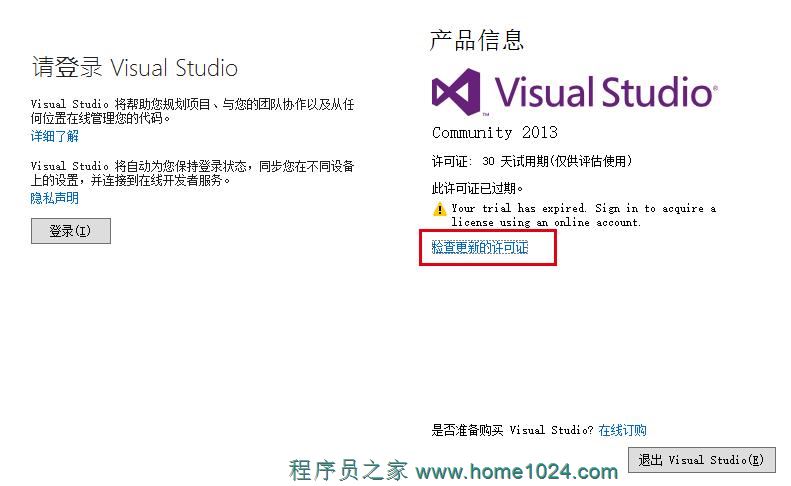SQLServer EVENTDATA()函数来获取DDL 触发器信息
实现代码如下:-- Create a log table CREATE TABLE TriggerLog (LogInfo xml) -- Create a dummy table to delete later on CREATE TABLE TableToDelete (Id int PRIMA

VisualStudio许可证过期的解决思路:0、打开VS弹出许可证已经过期,找到检查更新许可证点击更新许可。1、 关掉VisualStudio,重新以管理员身份打开,如果正常进入软件界面,点击【帮助】>【注册产品】,输入密钥KEY即可,密钥可以通过百度对应版本找到。2、 如以上方式没用,可找

2022年了,Jetbrains从2021.2.3版本开始就要登录了,以前的无限重置的方法就不好使用.下面是激活Jetbrains系列产品IDEA2021.2.2,AppCode2021.2.2,CLion2021.2.2,DataGrip2021.2.2,GoLand2021.2.2,PhpStorm2021.2.2,PyCharm2021.2.2,Rider2021.2.2,RubyMine2021.2.2,WebStorm2021.2.2等的破解教程

IDEA 2021.3.3中文永久破解版激活码注册破解中文版下载免注册永久激活版,亲测真实有效:激活教程

今天开发sso登录认证相关在用HttpClient设置ContentType时报错:xxx头名称误用。请确保将请求头用于 HttpRequestMessage,将响应头用于HttpResponseMessage,将内容头用于HttpContent对象。代码如下: HttpClient.Default
实现代码如下:-- Create a log table CREATE TABLE TriggerLog (LogInfo xml) -- Create a dummy table to delete later on CREATE TABLE TableToDelete (Id int PRIMA
declare @TopCount int set @TopCount = 100 select top (@TopCount) * from AdventureWorks.HumanResources.Employee 如果有Like等字句,一定要拼Sql的话,也应该使用sp_executesql
一、问题 给了两个各有四五十个列的表,找出他们相同的列和不同的列二、查询两个表的列,存在临时表--#a ,#b都是临时表,当前连接断开后自动删除--RANK() OVER (ORDER BY syscolumns.name DESC) AS 是SQL2005支持的,在每行记录前加上自增序号--IDE
SQLServer Access CASE...WHEN... IIF() SUBSTRING() MID() ISNULL() IIF(IS NULL) SELECT *,IIf([State]=1,'√','×') as StateTag FROM Leave order by id desc
远程连接sql server 2000服务器的解决方案 一 看ping 服务器IP能否ping通。 这个实际上是看和远程sql server 2000服务器的物理连接是否存在。如果不行,请检查网络,查看配置,当然得确保远程sql server 2000服务器的IP拼写正确。 二 在Dos或
根据实现策略的不同,主要有快照复制、事务复制、合并复制等三种类型。这三种复制类型,各有各的特点,分别适用于不同的场合。一般来说,在考虑采用哪种复制类型比较合适的时候,主要考虑的是性能与数据同步的时间间隔。那么在什么情形下比较适用快照复制呢?笔者就跟大家来讨论一下这个话题。 为了在恰当的时候采用快
首先,看一下sql server,之前我们都通过前台用户选择一个起始时间和一个结束时间(以日为最小单位),然后来作为条件进行查询,如果直接通过”between starttime and endtime”来作为条件的话,发现会自动将”2009-06-17”转化为” 2009-06-17 00:00:
对于 SQL SERVER 2000 及更早的版本,需要使用一个自增列,结合临时表来实现。 实现代码如下:SELECT [AUTOID] = IDENTITY(int,1,1), * INTO #temp_table FROM 表名; 实现代码如下:SELECT * FROM #temp_table
/*存储过程*/ sp_databases --列出服务器上的所有数据库 sp_server_info --列出服务器信息,如字符集,版本和排列顺序 sp_stored_procedures--列出当前环境中的所有存储过程 sp_tables --列出当前环境中所有可以查询的对象 sp_start_
查询资料后知道有 sp_addlinkedserver 这个系统存储过程,可通过ODBC连接MySql,于是下载ODBC驱动,这个可通过MySql官网得到,地址:http://dev.mysql.com/downloads/。 安装驱动后配置数据源,这里注意,要用系统数据源,我在用户数据源中配置后数